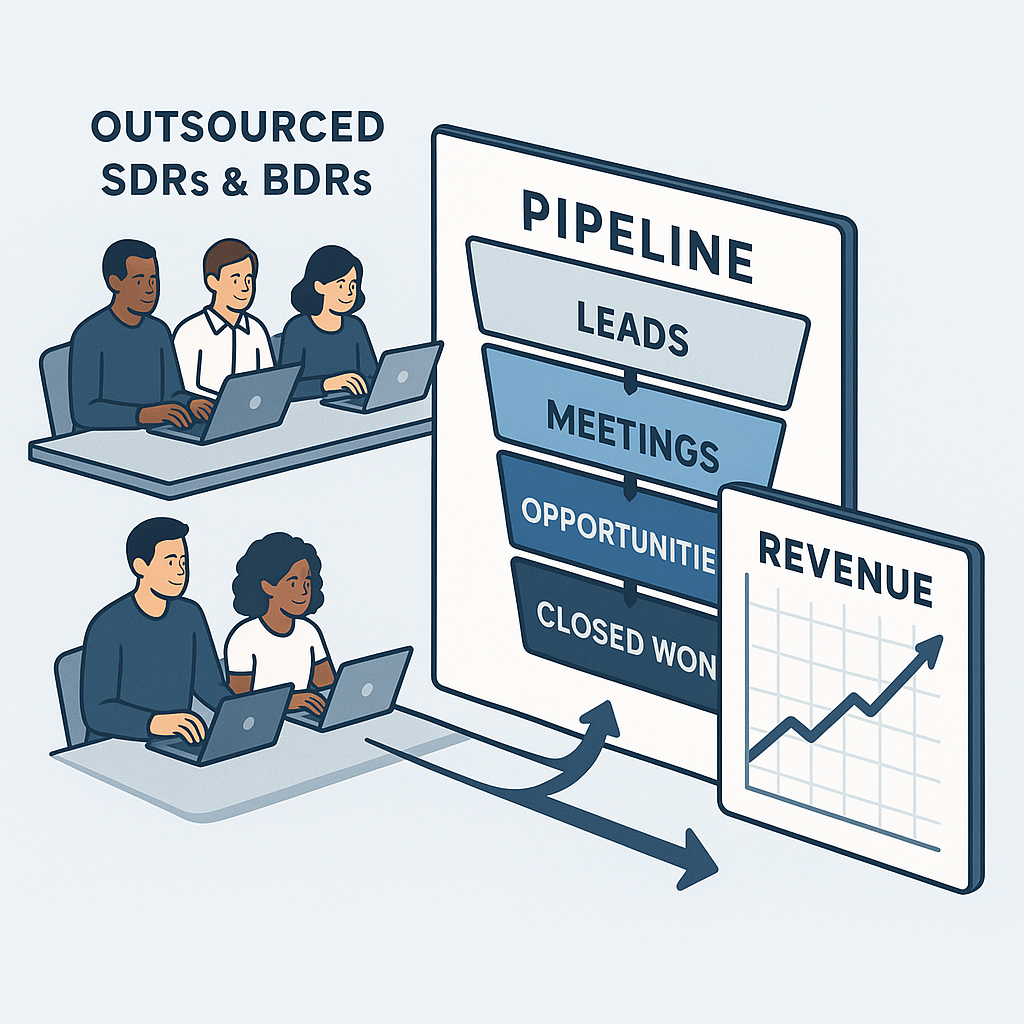How SDRs Drive Sales Growth: The Key to Better Leads & Faster Deals
Missed a big deal last quarter because your sales team was chasing dead-end leads? In today’s cutthroat market, businesses live or die by their...
%20(23).png?width=302&height=302&name=_SD%20web%20assets%202025%20(500%20x%20500%20px)%20(23).png)
6 min read
Eric Smith
:
Aug 22, 2025 4:00:00 PM
How many deals are your SDRs losing simply because they gave up too soon?
If you're a marketing manager watching leads vanish after one unanswered message, it’s not your ICP or product holding you back. It’s your cadence discipline. A weak follow-up strategy quietly kills the pipeline, and most teams don’t even realize it’s happening.
As of August 2025, data shows 80% of sales require 5 or more follow-ups, yet 44% of SDRs stop after just one. That gap isn’t just a lost opportunity. It’s operational waste. In B2B sales, consistency doesn’t just matter; it compounds. A structured, multi-touch sales cadence keeps your reps visible and your pipeline moving.
Most reps underestimate the effort it takes to earn attention. In B2B, one or two touches won’t cut it. The sweet spot? 8 to 12 well-timed, multichannel touchpoints over 2 to 4 weeks.
High-performing SDR teams rely on structured cadences such as email, cold calls, LinkedIn, and voicemails to create familiarity and trust. According to the Bridge Group, sequences with 11 or more touches see up to 10% higher conversion rates than short cadences of six or fewer.
This isn't about flooding inboxes. It's about showing up with relevance and rhythm. Frequency signals intent. Done right, it builds credibility, not desperation.
Too many reps assume silence equals rejection. One ignored email, and they move on. But in reality, no response usually means wrong timing, not lack of interest.
Top-performing SDRs don’t chase replies. Rather, they nurture relevance. Each touchpoint delivers value, context, and timing cues. They trust the sales sequence to do its work. That mindset shift reduces burnout and creates real opportunities over time.
If your SDRs are focused only on quick wins, they’re burning leads that would convert later with consistent, low-pressure follow-up.
According to research from InsideSales (now XANT), 50% of sales happen after the fifth follow-up. Yet most sequences still end too early to see those results. That’s a system failure, not a talent issue. GrowthList reports that nearly 80% of sales close between the fifth and twelfth touch. But those touches only work when they’re planned, spaced, and tracked.
Sales development teams using three or more channels in their outreach—email, phone, LinkedIn—see significantly better outcomes. One Bridge Group report showed a 28% higher conversion rate when reps used multiple outreach types in a single cadence.
Tools like Salesloft and Outreach back this up with clear benchmarks—diverse cadences consistently outperform single-channel outreach across key metrics.
Cadences with 12 to 16 touchpoints consistently outperform shorter sequences. That cadence length gives reps time to build familiarity, test timing, and adjust tone based on engagement. Longer cadences don’t mean spam; they mean structure. And structure wins.
Most SDR teams don’t lack effort—they lack systems. A strong sales cadence aligns your marketing and sales teams, protects your inbound leads, and keeps outbound efforts from stalling. For marketing managers, this means knowing how long it actually takes to move a lead from cold to qualified. For SDRs, it means trusting the process instead of reacting to silence.
Tracking cadence length, channel mix, and engagement patterns helps your team optimize without guessing. Use tools like HubSpot, Salesloft, or Varicent to measure what works—and kill what doesn’t.
A strong sales cadence sounds simple on paper: follow up consistently, across channels, with the right timing. But most internal SDR teams fail to sustain it. Why? Not because of bad intent, but because of broken execution.
In fast-paced B2B sales environments, even top reps get derailed by overload, manual processes, and a lack of visibility. Without the right systems, consistency collapses, and with it, your sales pipeline.
Internal SDRs wear too many hats: research, calls, emails, CRM updates, meetings. As new prospects roll in, follow-ups on warmed leads get pushed aside. That’s how cadences break—quietly, gradually, and often unnoticed.
The problem isn’t just time; it’s prioritization. Without automated sales cadence tools, reps react instead of executing. Time blocking and templated outreach sequences help, but discipline only scales with structure.
Writing every message, dialing each sales call, logging every touchpoint—it’s unsustainable. Manual sales outreach slows reps down and drains energy. Even the most motivated sales development representatives can’t maintain quality at scale without help.
This isn’t a rep performance issue. It’s a sales process flaw. To sustain a strong cadence, automation must support personalization, not replace it.
Tools like Salesloft or Cognism can help reps automate intelligently, not robotically. For teams ready to scale follow-up without hiring overhead, SmithDigital’s BDR Services offer built-in structure and execution at scale.
If your sales and marketing teams can’t see cadence metrics—open rates, touchpoint gaps, response rates, or drop-offs—then no one can optimize. And if no one owns the data, accountability disappears.
Tracking activity metrics, like average cadence length or reply time by channel, helps leadership spot where cadences fail. Without visibility, your best SDRs go unsupported, and your worst performers go unnoticed. Tools like Varicent can surface SDR-specific KPIs across teams, helping managers assess the real effectiveness of your cadence—not just volume.
Outsourcing SDR functions isn’t just about saving money. It’s about gaining consistency and aligning with a smarter SDR & BDR outsourcing strategy built for scale. While internal teams struggle to maintain follow-up, outsourced providers are built for scale and structured to sustain a strong sales cadence.
Internal SDR teams often get stretched thin—handling research, inbound leads, and internal tasks. That scatter kills cadence. Outsourced SDRs, by contrast, focus solely on outbound sales. They run 10–15 touch cadences with predictable rhythm across email, LinkedIn, phone, and voicemail. This level of execution is what fuels consistent lead generation and keeps the sales cycle moving.
Hiring an in-house sales rep can top $8K/month with tools, onboarding, and overhead. Turnover makes that worse. Outsourced options average 30–40% less, and ramp faster. Because they already follow sales cadence best practices, you skip the build-up and start moving prospects through the funnel immediately.
External providers use SLAs, structured cadences, and weekly reporting. With sales cadence tools and clear activity metrics, you always know what’s happening—without micromanaging. For sales and marketing teams, this visibility improves alignment and performance.
Platforms like Varicent tie rep activity to pipeline impact, so you're not just tracking touches, you're tracking outcomes. SmithDigital’s BDR services integrate structured cadences, reporting, and multichannel delivery without adding internal management overhead.
Most marketing teams don’t need another dashboard. They need a cadence system that actually runs. Tools are only as useful as the process behind them. A strong sales cadence isn’t just well-timed; it’s structured, repeatable, and optimized for B2B buyer behavior.
Here’s how to build a cadence engine that sustains momentum without burning out your SDRs:
Good automation doesn’t make you sound like a robot. The best sales cadence tools, like Salesloft or Outreach, allow your SDR team to pre-build sequences while adding context per prospect, such as recent activity, job change, or ideal customer profile match.
This is how you scale personalization. Use dynamic fields, send at the right time zones, and track sales cadence examples that perform. Done right, automation supports the rep—it doesn’t replace the salesperson.
The best outbound sales cadence isn’t built on email alone. A multi-channel mix, including email, phone, LinkedIn, and even voice mails, gives reps more chances to match timing with the decision-maker’s buying window.
Sequence matters. Start with a low-pressure intro email. Then follow up with a call. Add a social touch next. Each interaction should offer new relevant content or value, not repeat the same ask.
Weekly reviews of activity metrics, including open rates, reply rates, bounce rates, and conversion rates, tell you what works.
Clone high performers. Kill what’s stale. Use platforms like HubSpot or Varicent to tie SDR metrics directly to revenue outcomes. Monitor drop-off points, channel effectiveness, and content performance. The effectiveness of your cadence depends on iteration. Without tracking, even the best sales strategy stalls.
In B2B marketing, most sales teams quit too soon. That’s where you win. A well-run, effective sales cadence doesn’t just increase response rates; it separates you from competitors who vanish after the second email.
Cadence requires structure, timing, and relevance. A thoughtful multitouch sequence across email, phone, and platforms like LinkedIn keeps your brand visible without being annoying. Each touchpoint adds familiarity and trust, especially when it delivers value tied to the decision-maker’s needs.
Done right, persistence becomes your social proof. It shows you’re consistent, attentive, and serious about helping, not just making sales. Whether your team is human-led or supported by AI-powered tools, follow-through is your top-performing sales asset.
If your internal team struggles to maintain outreach consistency, you're not alone—and you're not stuck. Outsourcing gives you access to the structure, tools, and cadence discipline that most in-house teams simply can’t sustain.
For many marketing teams, outsourcing isn’t just a cost decision—it’s a performance move. It lets your team focus on strategy while specialists drive the sales cadence that turns prospects into pipeline.
Try our 90-day pilot to see how SmithDigital’s BDR service delivers persistence that pays off. Let us build your follow-up engine.

Missed a big deal last quarter because your sales team was chasing dead-end leads? In today’s cutthroat market, businesses live or die by their...

Building a consistent pipeline has never been more complex. Marketing and sales leaders are under pressure to fill funnels, drive revenue, and...

Looking for a quick way to maximize your marketing spend? Perhaps adding a Business Development Representative (BDR) or a Sales Development...